Do you have a craft stash at your home? In your collection of crafting supplies,…
The post Creative Reuse Centers Benefit Communities & the Planet appeared first on Earth911.

Do you have a craft stash at your home? In your collection of crafting supplies,…
The post Creative Reuse Centers Benefit Communities & the Planet appeared first on Earth911.
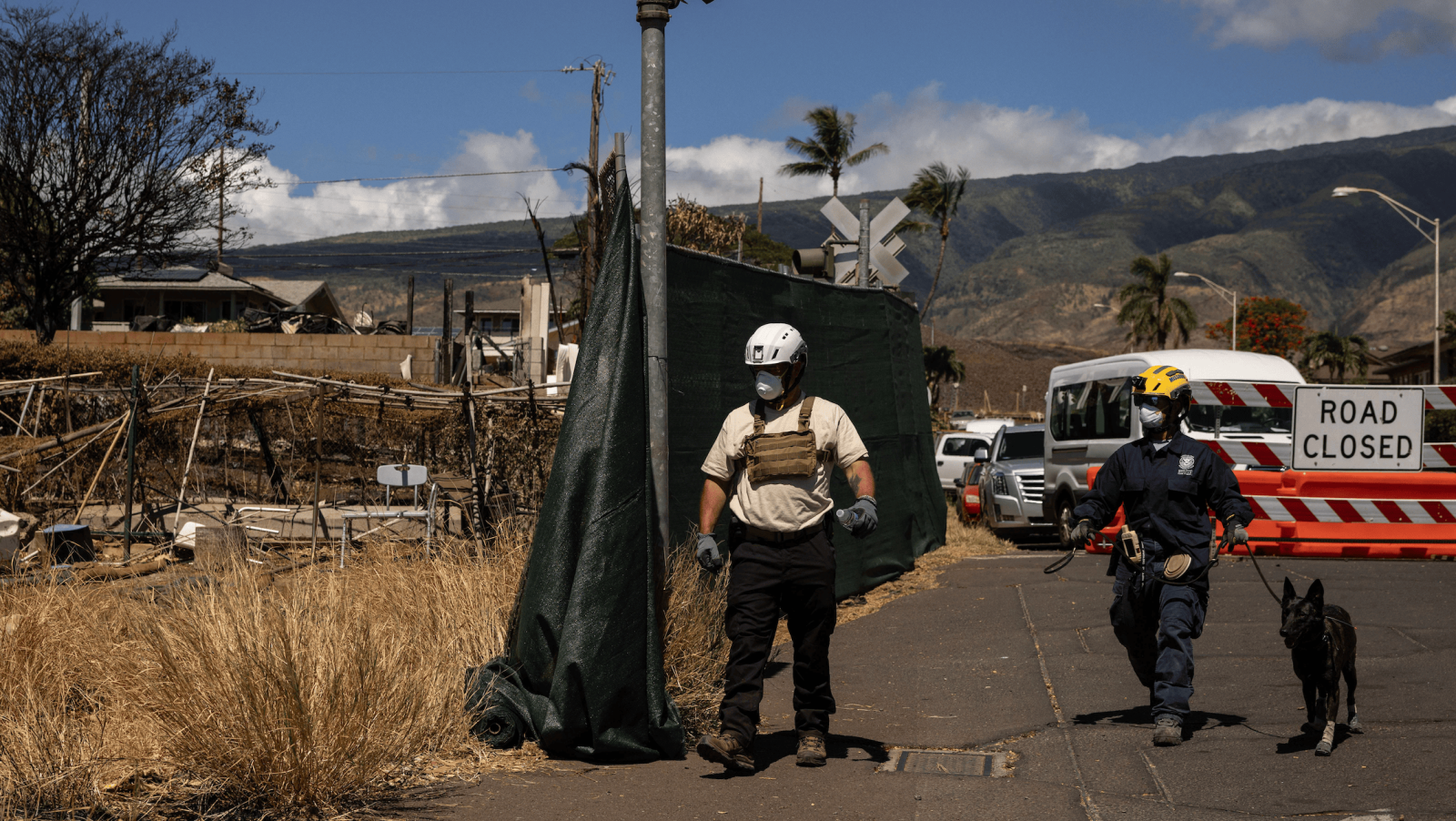
Mike Strain, the commissioner who runs the Louisiana Department of Agriculture and Forestry, stared out the window of a Black Hawk helicopter on Tuesday, hovering over land that had become unrecognizable. From thousands of feet up in the air, he could observe the transformative effects of the drought that had gripped the state all summer long. Lakes and ponds lay completely empty, their beds cracked. Swatches of earth that would be, on a normal year, lush and green had turned brown. Acres of evergreen trees — oaks and magnolias and azaleas, signatures of the state — had begun to wither.
“It looks like West Texas,” Strain told Grist, the surprise evident in his voice.
These dry conditions have helped ignite a spate of wildfires across the state. In an average year, wildfires burn roughly 8,000 acres in Louisiana; fires in August alone have set alight more than 60,000. The worst of them, the Tiger Island Fire, currently burning near the southwest border with Texas, has taken out 30,000 acres so far, and is being called the largest wildfire that Louisiana has seen in 80 years. Two towns near that fire have been evacuated, and Strain announced a statewide burn ban as his agency and the state fire marshal’s office have struggled to respond to a kind of natural disaster uncommon in the swampy state, one of the country’s wettest.
The fires follow a summer of record-breaking heat and dryness across Louisiana. Shreveport in northwest Louisiana had its second warmest summer on record; New Orleans had its second driest. According to Danielle Manning, a lead meteorologist at the National Weather Service New Orleans/Baton Rouge forecast office, the city of Alexandria in central Louisiana had its warmest summer on record by a large margin — by nearly 2 full degrees — and a nearby fire led the police to close roads over the weekend.
Manning traced the unusually hot and dry conditions to late May, when a system of high pressure air parked over the state and has stuck around since. Some places haven’t seen rain since the spring.
“It’s not unusual to be underneath high pressure [air] at times during the summer, but for it to be as persistent as it was this summer is extremely unusual,” Manning said, adding that the frequency of extreme conditions like these are expected to increase in a warming climate.
The drought, in combination with record-breaking heat, has sucked many of Louisiana’s characteristic bayous dry. Stock ponds that farmers have relied on for generations to water their cattle are empty. The detritus left from hurricanes in recent years have made these conditions even riper for wildfires — fallen timber from hurricanes Laura, Delta, and Ida lay across approximately one million acres of the state, according to Strain. In such conditions, wildfires start easily, Manning said. A single lightning strike or trailer chains dragging along a highway could set one off.
Officials that Grist spoke to said that they plan to request help from the state to fight future wildfires, in case this summer’s conditions turn out not to be an anomaly. Strain hopes to expand his firefighting force by 50 personnel and to obtain additional firefighting equipment like bulldozers and air tankers. Ashley Rodrigue, a spokesperson in the state fire marshal’s office, said that while her agency has never dealt with wildfires of this magnitude before, the experience of working in a disaster-prone state has helped to mobilize quickly.
“You can think of it like football — the game is the same,” Rodrigue said. “But the play-calling based on where you’re at in the game is what changes, and in this instance, the play is for wildfires.”
Nonetheless, there have been some challenges: When a fire department is depleted of energy or equipment, the fire marshal’s office is supposed to step in and support them by finding additional resources. One of the things that they’re finding, Rodrigue said, is that some fire departments don’t always know what to ask for, because they haven’t dealt with anything of this scale before.
The National Climate Prediction Center has forecasted a 50 to 60 percent chance that conditions across Louisiana return to normal by mid-September. The Tiger Island Fire doubled in size over the weekend, but in a visit to the town of DeRidder on Tuesday, Governor John Bel Edwards, a Democrat, said that recent rain has slowed the blaze. That fire was 50 percent contained as of Tuesday.
This story was originally published by Grist with the headline Even the bayous of Louisiana are now threatened by wildfires on Aug 31, 2023.
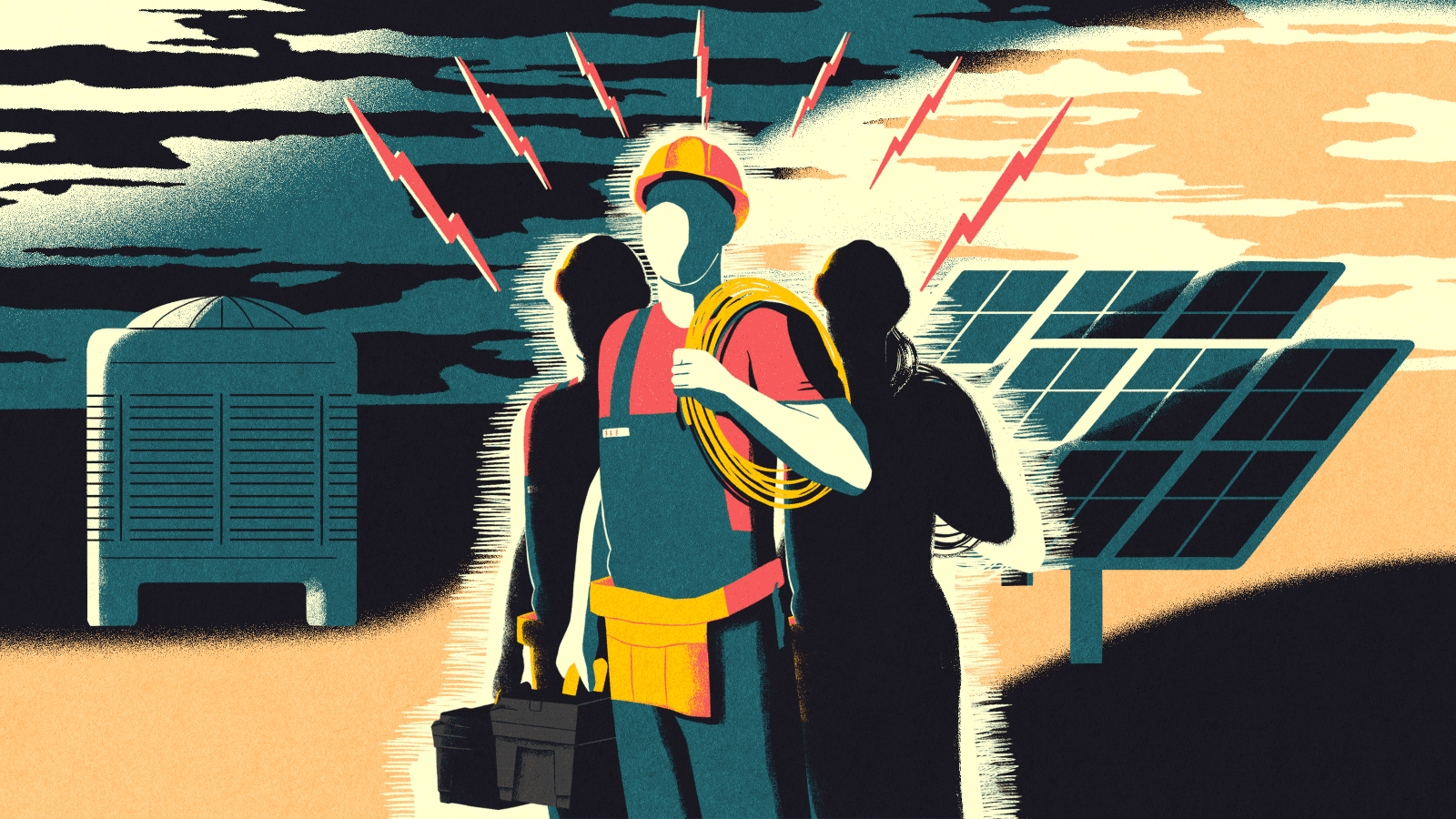
Making homes more efficient and more electric is critical to combating climate change. But the undertaking can be expensive and beyond the financial reach of many families.
Help, however, is on the way.
Residential energy use accounts for one-fifth of climate-warming greenhouse gas emissions in the United States. President Biden’s landmark climate bill, the Inflation Reduction Act, takes aim at this issue by allocating $8.8 billion to home energy efficiency rebates primarily for at low- and moderate-income households.
“For the federal government, this is the largest investment in history,” said Mark Kresowik, senior policy director at the nonprofit American Council for an Energy-Efficient Economy. “These rebates have the potential to provide tremendous support, particularly for low-income households, in terms of reducing pollution, reducing energy costs, and making homes more comfortable.”
States will administer the rebate programs under guidance the Department of Energy released in late July. The money could become available to consumers as early as the end of this year, though the bulk is expected throughout 2024. In some cases, the incentives could cover the entire cost of a project.
Incentives will fall into two buckets, with about half designated for home electrification and the remainder going toward overall reductions in energy use. The funding will be tied to household income.
States must allocate about 40 percent of the electrification money they receive to low-income single-family households and another 10 percent toward low-income multifamily buildings. The rest of the electrification rebates must go to moderate-income households. These are minimums, said Kresowik, noting that states can, and some likely will, make even more of the rebates need-based.
Income limits are location dependent and set by the Department of Housing and Urban Development. Low income is defined as 80 percent of area’s median household income, while moderate income is up to 150 percent. What that means can vary widely. In San Francisco, for instance, the low income threshold for a family of four is $148,650, while in Bullock County, Alabama it’s $52,150.
The rebates also are larger for low-income households. On the electrification front, the guidelines call for up to $8,000 for heat pumps, $840 for induction stoves, and $4,000 to upgrade an electric panel, among other incentives. That said, no single address can receive more than $14,000 over the life of the program. The discounts are largely designed to be available when the items are purchased, which avoids having to paying out of pocket and waiting for a check from the government.
“These are advanced technologies. Therefore they often cost more, but they save more energy and help save the climate,” said Kara Saul-Rinaldi, president and CEO of the AnnDyl Policy Group, an energy and environment strategy firm. “If we want our low-income communities to invest in something that’s going to benefit everyone, like the climate, we need to provide them with additional resources.”
For the energy-reduction incentives, the type of technology used doesn’t matter as long as households lower their overall energy use. Homeowners could do this by installing more insulation, sealing windows, or upgrading to more efficient heating and cooling systems, among other options. The rebate amounts are a bit more complex to calculate but are based on either modeled or actual energy savings, and increase if you save more energy or are low income.
Kresowik says efficiency retrofits can cost $25,000 to $30,000 or more. For many people, the Inflation Reduction Act could help put such projects within reach for the first time. While a homeowner cannot claim both an electrification and efficiency rebate for the same improvement, the incentives can be added to other federal weatherization and tax credit initiatives and any offers from utility companies.
But the latest rebates will be available only after states have set up their respective programs. For that reason, “the families who most need that help will be better served to wait if they can,” said Sage Briscoe, director of federal policy for the electrification nonprofit Rewiring America. Of course, that may not be feasible if, say, an appliance breaks, but doing so could potentially net a low-income household thousands of dollars in savings.
“The key is to start planning,” Kresowik said of the coming rebates. Talking to a contractor now, he said, can position households to take advantage of the programs as soon as they start accepting claims.
The rebates, though, may not be available everywhere. Florida, Iowa, Kentucky, and South Dakota have so far declined to apply for Inflation Reduction Act funds and could reject the home energy rebates as well. That means a sizable number of Americans may not see a boon from these latest rebates, either because they earn too much money or live in a state that refuses to participate in IRA programs.
Federal tax credits, however, are available now to help anyone pursuing projects such as installing solar panels or heat pump water heaters. The credits reset annually, but because they offset tax liabilities, the ability to fully utilize them often depends on a filer’s tax burden.
“There are those among us who are privileged enough that they probably can go ahead and start making those investments now,” said Briscoe. Rewiring America is in the process of launching tools to help people plan for, claim, and receive incentives, which can be complicated. But experts say that even this influx in funding won’t ultimately be enough to meet the need nationally.
“This is just a drop in the bucket,” said Saul-Rinaldi. Kresowik notes that there are 26 million low income households that still use fossil fuels for heating. At $30,000 each, electrifying those homes alone would cost $780 billion.
Saul-Rinaldi also sees a risk that the current program is limited by quirks in the guidance from the Department of Energy that may keep some contractors from participating, such as mandating in-person energy audits, even when utility data would suffice. But, she says, there is still time to smooth out those issues, and she hopes that the programs are “so successful that there is a wide demand across the country for additional funds so that we can continue to upgrade and electrify America’s homes.”
Ideally, Briscoe wants to see high-efficiency appliances and design become the norm, and she thinks incentives can help push the market in that direction. Previous federal rebate efforts, such as a Great Recession stimulus bill included $300 million in appliance efficiency funding, didn’t quite do that. But Briscoe says this latest attempt through the Inflation Reduction Act is not only orders of magnitude more ambitious but also more holistic and works in concert with other programs — such as installer training initiatives — to ensure the rebates aren’t operating in a vacuum.
“There’s some real urgency to making sure that we try to get the fossil fuels out of our homes,” said Briscoe. “The climate isn’t going to wait.”
This story was originally published by Grist with the headline Electrifying your home is about to get a lot cheaper on Aug 31, 2023.
Scientists are managing the critically endangered kākāpō population in New Zealand using population sequencing. In addition to helping with kākāpō conservation, the project could also provide more information for similar projects to protect other threatened species.
“Using technology created by Google, we have achieved what is likely the highest quality variant dataset for any endangered species in the world,” Joseph Guhlin, post-doctoral fellow at the University of Otago, said in a statement. “This dataset is made available, through DOC and Ngai Tahu, for future researchers working with Kākāpō.”
The researchers created whole-genome sequence data for almost the entire remaining kākāpō population, or about 169 individuals as of 2018. The study led to the creation of a reusable code and other tools for experts in conservation genomics to use to protect other vulnerable species. It also created a deeper understanding of kākāpō biology, exploring susceptibility to diseases, egg fertility, growth and other biological factors. The researchers published their findings in the journal Nature Ecology & Evolution.
“Kākāpō suffer from disease and low reproductive output, so by understanding the genetic reasons for these problems, we can now help mitigate them,” explained Andrew Digby, the university’s Science Advisor for Kākāpō Recovery at the Department of Conservation. “It gives us the ability to predict things like kākāpō chick growth and susceptibility to disease, which changes our on-the-ground management practices and will help improve survival rates.”
Kākāpō, a nocturnal type of large, flightless parrot, is endemic to New Zealand and faces threats from disease, predators and infertility, according to the New Zealand Department of Conservation. These birds rely on fruiting rimu trees for breeding, so they breed only every few years, Reuters reported. Because they don’t fly, kākāpō are especially vulnerable to non-native predators who have been introduced to New Zealand over the years.
Conservation efforts are helping the population recover, though. There were only 86 individuals in 2002, Deidre Vercoe, the operational manager for government’s Kākāpō Recovery program, told Reuters. From 2021 to 2022, the population increased 25% to 252 individuals.
The authors of the study on kākāpō sequencing hope that their research will help inform kākāpō conservation decisions and further conservation efforts for other species.
“The Kakapo125+ project is a great example of how genetic data can assist population growth,” Digby said. “The novel genetic and machine learning tools developed can be applied to improve the productivity and survival of other taonga under conservation management.”
The sequencing project was funded by Genomics Aotearoa, a group of research institutions and universities focused on genomics and bioinformatics in New Zealand.
The post Sequencing Project Helps Conservation Efforts for Critically Endangered Kākāpō appeared first on EcoWatch.
Hurricane Idalia made landfall in the Big Bend area of Florida at 7:45 a.m. today after strengthening into a Category 3 storm in the Gulf of Mexico.
Idalia began as a tropical storm that passed to the west of Cuba, cutting off power and causing major flooding and evacuations.
Florida’s coastal residents were anticipating a surge of flood waters of up to 16 feet, with warnings posted from Sarasota to Apalachicola Bay, reported Reuters.
“We fear that residents will walk outside, see it’s sunny outside and think everything’s fine. But there’s more water coming,” said Rob Herrin, Hillsborough County Fire Rescue spokesperson, as CNN reported. “There’s still so many hazards after the winds and rains have cleared.”
When Idalia made landfall sustained winds were 125 miles per hour, making it the strongest hurricane to hit Big Bend since records started in 1851, The Weather Channel said.
Idalia made landfall in Taylor County at Keaton Beach this morning at 7:45 a.m., reported Reuters. Waters had reached eight feet at a monitoring station in Steinhatchee, two feet higher than the flood stage of six feet.
“Folks, this storm is not over. If you are in a safe location, please remain there,” said Emergency Management Director Timothy Dudley, pointing out that the cresting of local waterways would occur with high tide at 2:30 p.m., as Reuters reported.
Officials said there was widespread flooding and damage in Hillsborough County, an area with 1.5 million residents.
By 11 o’clock this morning, Idalia’s maximum sustained winds had lowered to 90 miles per hour, making the storm a Category 1 hurricane as it moved into Georgia and South Carolina, where hurricane warnings and other storm advisories have been issued.
“Idalia is likely to still be a hurricane while moving across southern Georgia, and possibly when it reaches the coast of Georgia or southern South Carolina late today,” the hurricane center said today, as reported by CNN.
More than 272,000 residences and businesses were experiencing power outages in Florida, according to PowerOutage.us.
Four to eight inches of rain could pummel the region through tomorrow, with some isolated places experiencing up to a foot of rain, warned the hurricane center, as Reuters reported.
“Time will tell on how bad it is… and we could have more” storms, said Deanne Criswell, administrator of the U.S. Federal Emergency Management Agency, as reported by Reuters. Criswell added that it has already been “a very active hurricane season.”
Florida has now had four major hurricanes in the last seven years, including last year’s Ian, Michael in 2018 and Irma in 2017.
The post Category 3 Idalia Strongest Hurricane to Hit Big Bend, Florida on Record appeared first on EcoWatch.
A new study by Joshua Pearce of London’s Western University and Richard Parncutt of the University of Graz in Austria has found that, if global heating reaches or surpasses two degrees Celsius by the year 2100, there is a high probability that over the next century humans, mostly the wealthiest, will be responsible for the deaths of approximately one billion mostly poorer humans.
Many of the most powerful and profitable businesses on the planet are part of the oil and gas industry, which is both indirectly and directly responsible for over 40 percent of carbon emissions, which impact billions of lives in some of the world’s most remote communities that have the least resources, reported Western News.
The study advises a substantive and immediate lowering of carbon emissions, as well as accelerated action by governments, corporations and citizens to decarbonize the global economy, with the goal of minimizing the number of human fatalities.
“Such mass death is clearly unacceptable. It’s pretty scary really, especially for our children,” said Pearce, who is Western’s John M. Thompson chair in information technology and innovation and the lead author of the study, as Western News reported. “When climate scientists run their models and then report on them, everybody leans toward being conservative, because no one wants to sound like Doctor Doom. We’ve done that here too and it still doesn’t look good.”
The study, “Quantifying Global Greenhouse Gas Emissions in Human Deaths to Guide Energy Policy,” was published in the journal Energies.
For the study, the researchers reviewed more than 180 scientific articles and found that they intersected on what is called the “1,000-ton rule,” which estimates that one premature death will be caused each time about 1,000 tons of fossil fuels are burned.
“Energy numbers like megawatts mean something to energy engineers like me, but not to most people. Similarly, when climate scientists talk about parts per million of carbon dioxide, that doesn’t mean anything to most people. A few degrees of average temperature rise are not intuitive either. Body count, however, is something we all understand,” said Pearce said, as reported by Western News. “If you take the scientific consensus of the 1000-ton rule seriously, and run the numbers, anthropogenic global warming equates to a billion premature dead bodies over the next century. Obviously, we have to act. And we have to act fast.”
Pearce hopes that more industry leaders and policymakers will begin to face the consequences of humans’ reliance on fossil fuels when confronted with updated metrics and language surrounding global warming.
“As predictions of climate models become clearer, the harm we are doing to children and future generations can increasingly be attributed to our actions,” Pearce said.
Once the cause and effect between greenhouse gas emissions and the resulting consequences to the environment and human health become clear, so do the liabilities.
The study said that, in order to mitigate climate change, energy policy should focus on the main areas of the total replacement of oil, natural gas and coal with zero carbon fuels like electricity and hydrogen derived from renewable sources like wind, solar, geothermal, biomass and hydropower; improvements in energy efficiency and conservation; carbon taxes to replace carbon subsidies; and the development of carbon waste management technologies, as well as regenerative agriculture and natural carbon sequestration.
“To be clear, predicting the future accurately is hard. The 1000-ton rule is only an order of magnitude best estimate. The number of caused deaths will likely lie between a tenth of a person and 10 people per 1,000 tons. Regardless, the bottom line that we need to act fast is still crystal clear,” Pearce said, according to Western News. “Global warming is a matter of life or death for a billion people. Almost everyone agrees that every human life is valuable, independent of age, cultural or racial background, gender or financial resources. Therefore, the energy transition will have to change much, much faster, starting now.”
The post ‘We Have to Act Fast’: 2 Degrees of Warming Could Cause 1 Billion Deaths Over Next Century appeared first on EcoWatch.
This year’s first major hurricane made landfall early Wednesday morning, bringing 125 mile per hour winds to Florida’s Big Bend region. Officials and residents told Grist that the sparsely populated coastal area, which stretches from near Gainesville to just south of Tallahassee, was wholly unprepared for Hurricane Idalia, a Category 3 storm fueled by exceptionally hot waters in the Gulf of Mexico. The area hasn’t been struck directly by a hurricane in more than a century.
“We’ve never seen anything like this,” said Mandy Lemmermen, the battalion chief for the Dixie County fire department, who was hunkered down in an operations center in the county seat of Cross City when she spoke to Grist on Tuesday evening. “You can’t survive this.”
After taking shape in the Gulf of Mexico, Idalia underwent a process known as “rapid intensification,” swiftly strengthening from a tropical storm to a Category 4 hurricane as it passed over the hot waters of the Gulf of Mexico, then weakening just before it made landfall. The most devastating Atlantic hurricanes of the past few years, including 2022’s Ian and 2021’s Ida, have all undergone this process. Scientists believe that climate change is making it more common.
By early morning Wednesday, just minutes after landfall, the storm had already pushed more than six feet of storm surge over the island town of Cedar Key, submerging many buildings in the beachfront area. A similar tide was flowing up the Steinhatchee River, where it was poised to cause similar flooding. More than 160,000 customers in the state had lost power, and more than 20 counties across the state had issued some form of mandatory evacuation order. Areas as far north as Georgia and South Carolina were expected to see rain damage, and areas as far south as Tampa Bay and St. Petersburg had already experienced flooding as winds pushed storm surge into city streets.
But the longest-lasting effects are likely to be in the rural communities along the remote Big Bend coast.
“It’s Waterworld there,” said Kathryn Frank, a professor of urban planning at the University of Florida who has worked with Big Bend communities on climate adaptation. “You have water coming from every direction, and that’s why it hasn’t developed much.”
Because the area is so flat, storm surge reaches farther inland than it does even in other parts of Florida. In Levy County, for instance, Frank’s team found that a Category 3 storm could inundate terrain as far as 20 miles away from the water’s edge.
The coastal shelf along the Big Bend is shallow and flat as well, which leads to much higher waves, increasing the depth of hurricane flooding. The National Hurricane Center estimated yesterday that Idalia would produce 12-foot surges along the coast, but Dixie County’s own hazard mitigation plan estimates that surges could reach as high as 24 feet, large enough to inundate almost every structure in coastal towns like Horseshoe Beach. The fact that the storm is arriving during a full moon, which produces higher tides, will make the surge even worse.
The region also floods from the inland side, because it sits atop the Floridan Aquifer, an underground water layer that discharges up to the surface when it rains. Rivers like the Suwanee and the Steinhatchee often flood for weeks at a time. The vast majority of land area in areas like Taylor County sits inside the hundred-year floodplain, indicating a level of risk that many cities like Houston have deemed unsustainable for development.
To make matters worse, residents often have limited resources to deal with flooding. The median household income in Dixie County is around $44,000, far below the national average. A recent report from United Way of the Big Bend found that far more families in the region are struggling to meet basic needs than in the rest of the state.
Some residents in Dixie County have already experienced prolonged displacement from even minor rainfall events. A series of floods back in the spring and summer of 2021 brought five feet of water to many houses in the county’s Old Town neighborhood, which sits on the Suwannee River, and locals were still waiting to get back into their homes in January of the following year.
“It feels like living in a swamp,” said Deena Long, who moved to a manufactured home in the area from Georgia in 2018. “The first two years, everything was underwater. It came right up to our trailer and our well house, and everything else was totally underwater, and it was the same for our neighbors on both sides.”
Long said she and her husband have to wear galoshes to walk through her yard, and they often see snakes floating around in the water. Nevertheless, she planned to stick it out at home during Hurricane Idalia. Long and other residents have blamed the county for not maintaining the area’s drainage infrastructure.
“There’s not enough culverts, there’s not enough drainage. It’s poor planning on the government’s part,” she told Grist. “It’s been a strong conversation, but nothing ever happens. It gets pushed back under the rug.”
Even several miles inland, in areas that sit higher off the ground, the winds were substantial on Wednesday.
“There are trees down in all directions,” said Rebecca Greenberg, a criminology graduate student who stayed behind in Dixie County to keep track of her dogs and horse. “I can hear loud booms. I think it’s trees or trailers or propane tanks getting blown down.”
Having struggled with even minor flood events, the Big Bend’s infrastructure is nowhere near prepared for a storm of Idalia’s magnitude. As of 2015, more than 30 percent of residents in Taylor and Dixie counties lived in mobile or manufactured homes, which can sustain huge damage or collapse altogether during big wind storms. A large portion also use residential septic systems, which can fail and backflow into homes. When Frank conducted a study of sea-level rise in Levy County, her team found that many coastal roads and wastewater plants would sink several feet underwater during even a mild storm.
“Even during dry seasons, it’s wet, so when you get a storm like this one, with a big storm surge, it can travel really far inland,” said Frank. “That’s very bad for environmental health.” It’s possible that septic and drinking water systems could be inoperable for weeks or months, she added.
Unlike in rural parts of the Louisiana coast, there are no levees or shoreline-protection projects that can control flooding. In the three coastal counties in Idalia’s path, which have a combined population of around 80,000, just 2,000 households buy flood insurance from the federal government, according to FEMA data. The state’s Resilient Florida grant program, which has spent millions on climate adaptation projects, has only funded a few planning initiatives in the Big Bend.
The roads in Long’s area are made out of dirt, so they become muddy and impassable even during mild rain. During the worst flood events over the past few years, she has relied on her neighbor to drive her out of the area on a tractor.
Idalia’s track over the rural Big Bend will likely ensure that overall monetary damages from the storm are far lower than for storms like Hurricane Ian, which hit a densely populated area. But for the people who do live in the Big Bend, the devastation could be total, according to Frank.
“The eye is going straight at these little towns, like Steinhatchee, that are just trying to make the best of it,” she said. “My heart goes out to that little little small town.”
This story was originally published by Grist with the headline ‘You can’t survive this’: Hurricane Idalia strikes Florida’s most vulnerable coast on Aug 30, 2023.
Women bring the skills, perspectives, and emotional intelligence necessary to achieve the green transition, address…
The post Best of Earth911 Podcast: Discover How The XX Edge Can Accelerate Sustainability & Equity appeared first on Earth911.
The USDA organic certification process and standards have room for improvement, but in the United…
The post Is Biodynamic Better Than Organic? appeared first on Earth911.
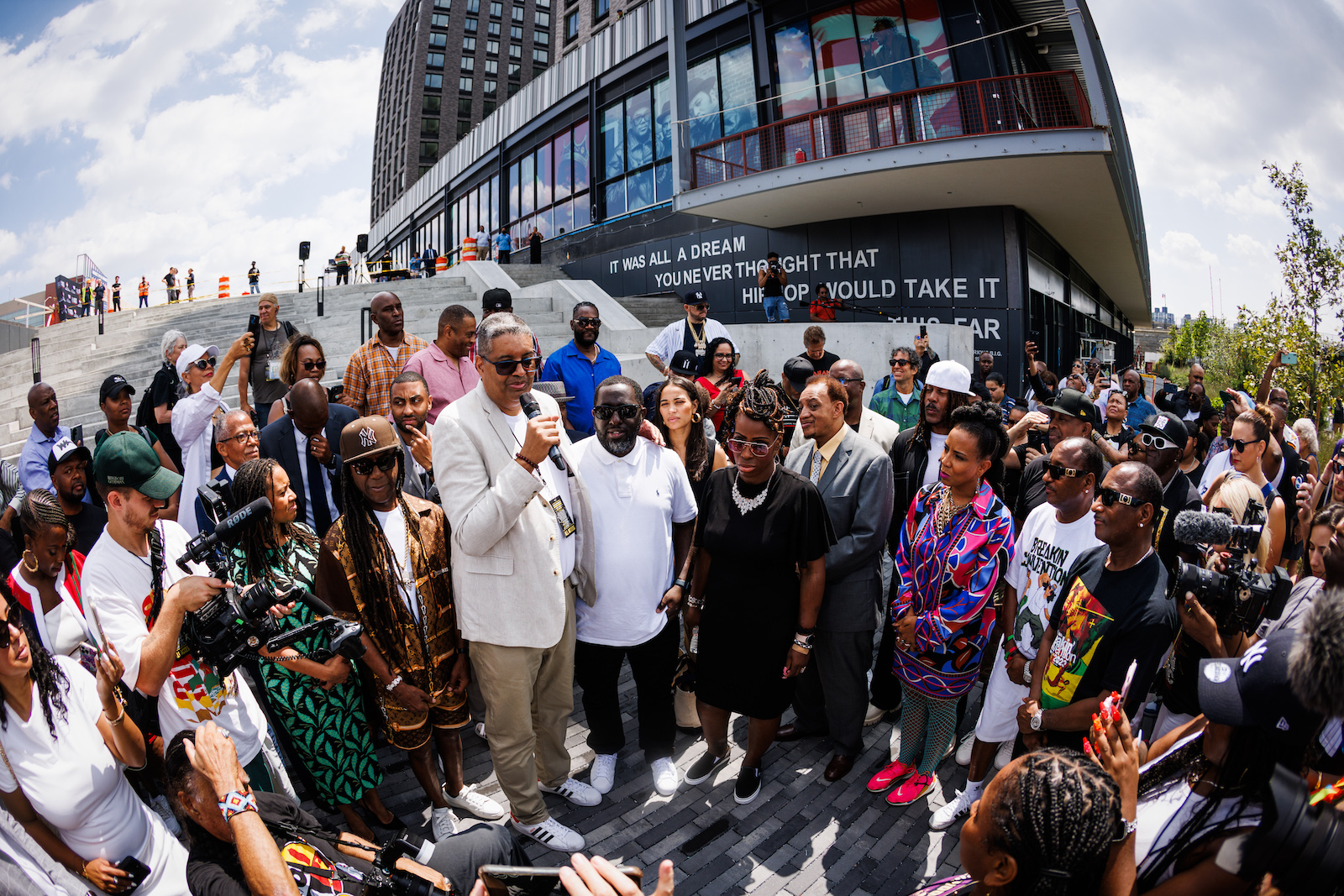
Under New York’s Major Deegan Expressway in the Bronx, through a set of doors wedged between a parking garage and a pizza shop, a gray and gold throne emblazoned with the letters “S” and “R” sits behind a pair of velvet ropes. The letters stand for “Slick Rick,” one of hip hop’s pioneering rappers, whose hits have been sampled more than 1,000 times by acts ranging from Snoop Dogg to Miley Cyrus.
Slick Rick himself donated the ornate chair to the Universal Hip Hop Museum, the genre’s long-awaited answer to the Rock & Roll Hall of Fame, set to open in early 2025 as part of a brand-new development on the other side of the Deegan. The museum will be a slightly belated anniversary tribute to hip hop, which turned 50 earlier this month. For now, Rick’s throne resides at the museum’s pop-up location in the Bronx Terminal Market.
“That basically is one of our most important artifacts,” the museum’s president, Rocky Bucano, told me on a recent visit. Bucano, 63, stands six foot eight, with matching stature in the hip hop world: The trailblazing DJ now works to preserve the larger-than-life legacies of artists like Rick. “When he put out his debut album on Def Jam, he took that throne with him on tour every day,” he added.

It’s no secret that hip hop’s most famous artists often glorify conspicuous consumption. Many of the genre’s lyrics and music videos create an aspirational energy around gas-guzzling luxury cars and private jets. Yet hip hop’s roots lie in activism, and it has long served as a voice on everything from systemic police brutality to discriminatory housing policies. The genre has also been sounding the alarm on what we now call environmental justice.
In recent years, many of hip hop’s New York havens have felt the impact of extreme weather events — from the lethal floods in Run D.M.C.’s Queens to the danger of rising waters in Cardi B’s South Bronx. The creative community has rallied in response to these climate-driven disasters, with stars donating their time and money to relief efforts. And it’s been reflected in the music as well — beyond the occasional nod from the likes of Pitbull, whose 2012 dance-oriented album Global Warming had more in common with Nelly’s hit single “Hot in Herre” than with David Wallace-Wells’ The Uninhabitable Earth, and beyond the nom-de-plume of Migos cofounder Offset (a merely coincidental reference to carbon credits).
Hip hop’s relationship to the environment, both in terms of lyrics and political activism, goes back to its very beginning, when smoke from apartment fires blackened the skies of the 1970s South Bronx. And yet its role in advocating for climate solutions has largely gone unnoticed.
“People have spent time bobbing their heads to our stories of this despair and not seeing it as a call to action,” said Michael Ford, the self-proclaimed “Hip Hop Architect” who designed the museum (and who was featured on the 2019 Grist 50 list). “Now, I think, is this generation’s opportunity to go back and look at 50 years of these unsolicited, sometimes unfiltered and raw stories of environmental injustices and climate change.”
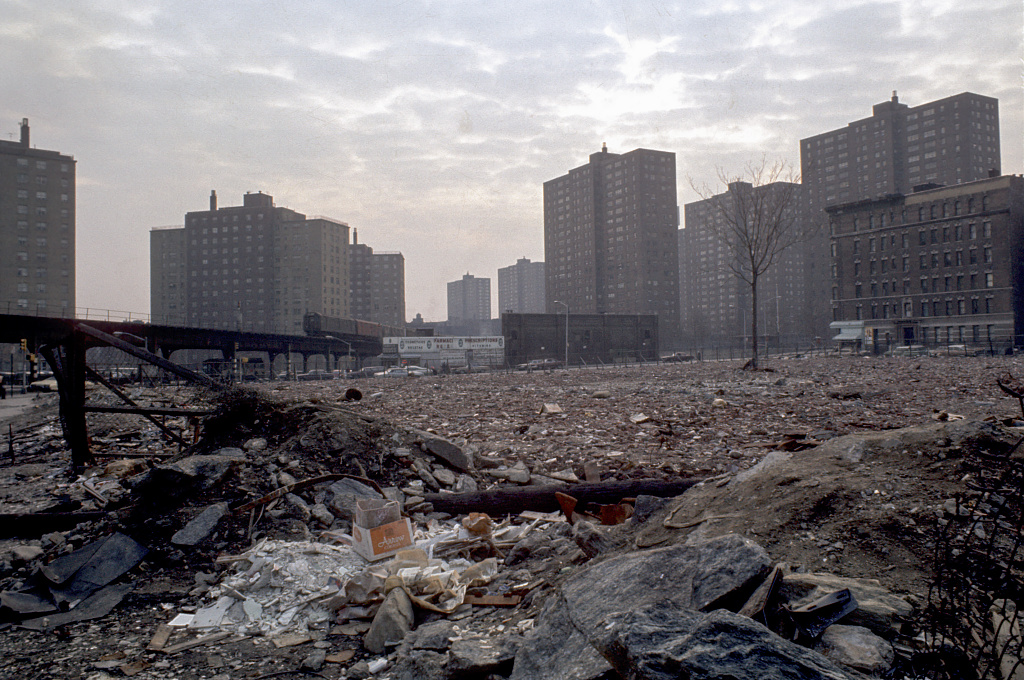
Hip hop dates back to August 11, 1973, when Clive “DJ Kool Herc” Campbell hosted a back-to-school party in a rec room at 1520 Sedgwick Avenue in the Bronx. His revolutionary innovation: physically manipulating two copies of the same record in real time to extend the “breaks,” or the danceable interludes, of popular songs.
Back then, the genre’s activism centered around the built environment, calling attention to egregious living conditions in places like the South Bronx. Grandmaster Flash and the Furious Five’s 1982 classic “The Message” served as perhaps the most potent example: “I can’t take the smell, can’t take the noise / Got no money to move out, guess I got no choice.”
“What is today called the climate crisis was in full effect in the underserved communities when this song was released,” said the Universal Hip Hop Museum’s Kate Harvie. “Whatever has been happening to the climate was first to affect unprotected and unrepresented lands.”
But as hip hop heated up through the 1990s, environmental advocacy took a back seat, at least until Hurricane Katrina hit in 2005. The storm uprooted scores of New Orleans residents, including the founders of Cash Money Records — whose roster, at the time, included Lil Wayne, Nicki Minaj, and Drake. (The company has since decamped to Miami.) Chief executive Bryan “Birdman” Williams told me he lost “20 houses, 50 cars, and memories” in the disastrous flood surge.
Artists like Jay-Z and Diddy donated seven-figure sums to Katrina relief efforts. Others, including Lil Jon and Ludacris, performed on charity telethons to aid disaster recovery. During one, Kanye West, incensed over the federal government’s feeble response in communities of color in New Orleans, famously declared “George Bush doesn’t care about Black people.”

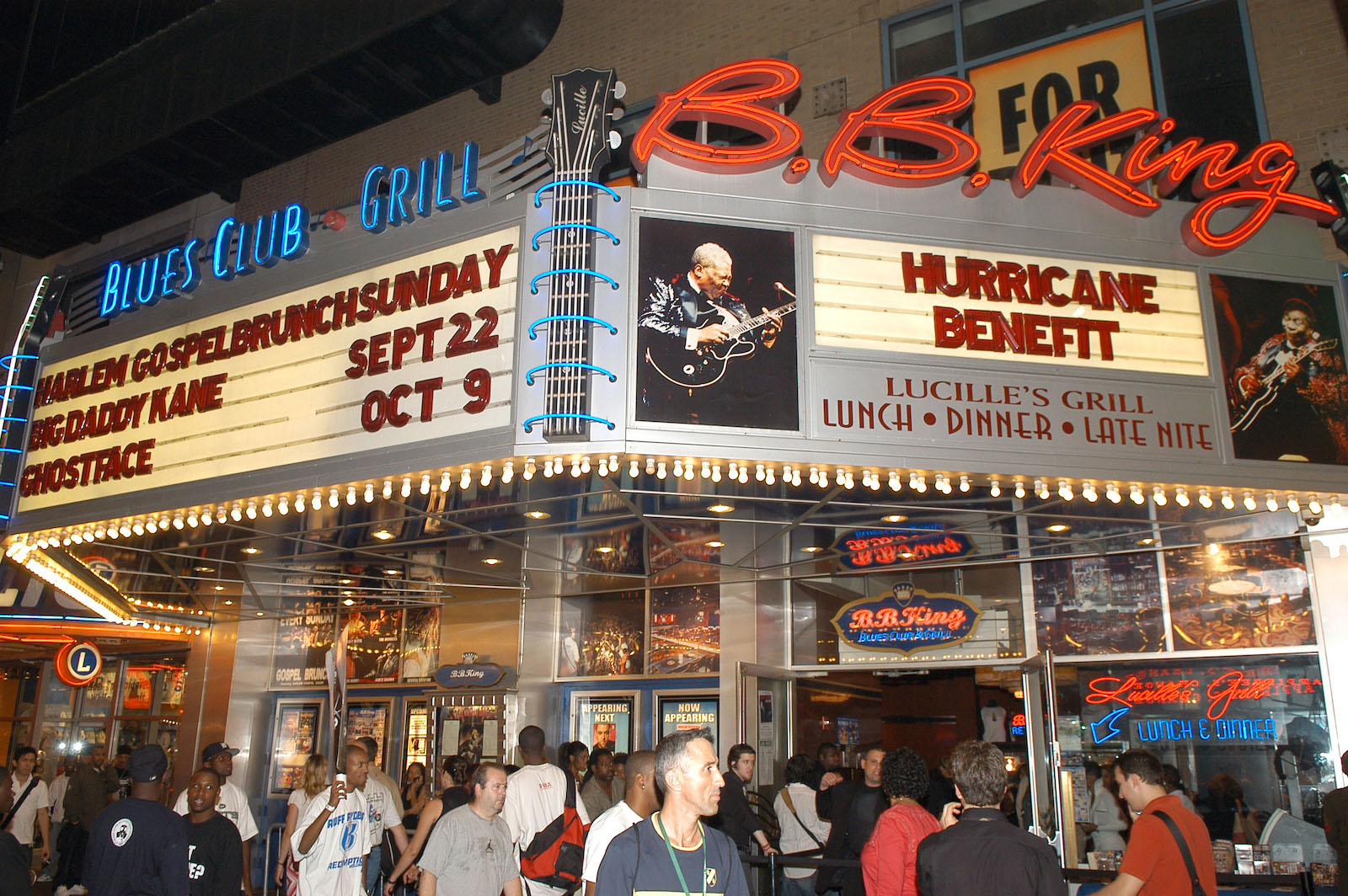
It wasn’t just musicians who were incensed. Reverend Lennox Yearwood Jr., a Louisiana native and president and CEO of the nonprofit group Hip Hop Caucus, also noted the disproportionate damage to New Orleans’ poorest neighborhoods. “Climate justice is racial justice, and racial justice is climate justice,” said Yearwood. “It was the Ninth Ward that was devastated and not the French Quarter.”
Yearwood got his start as a minister in 1994 and served as director of student activities at the University of the District of Columbia before signing on to run Diddy’s Vote or Die! initiative ahead of the 2004 presidential election. He saw unique potential in the hip hop community to mobilize for political, social, and environmental causes — including climate change.
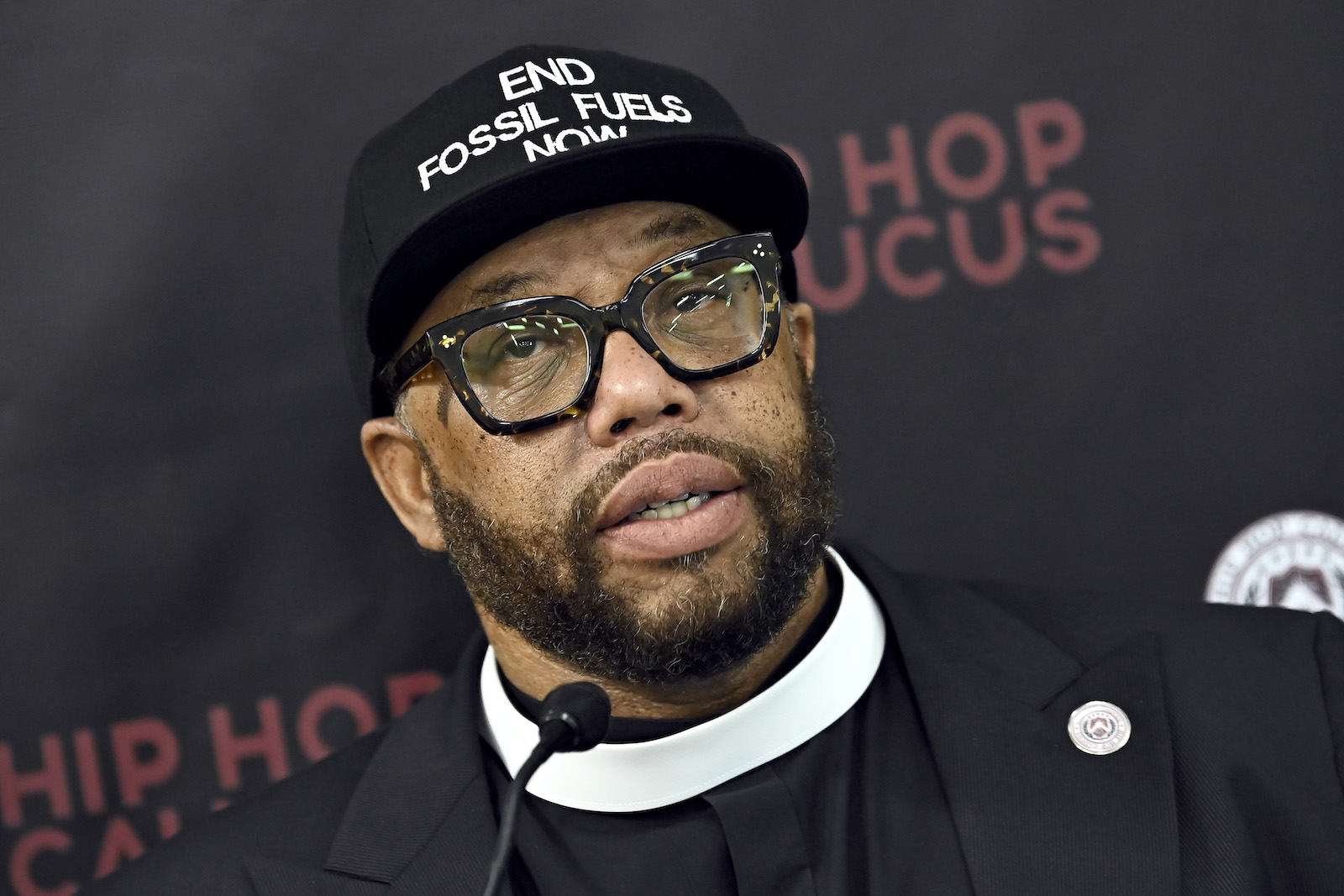
Black neighborhoods often sit in flood-prone areas, a consequence of historic segregation. Environmental racism — which also includes dumping of toxic materials and building highways that cut through communities of color — has led to higher rates of diseases from asthma to cancer. And climate change will continue to have a disproportionate impact, even beyond flooding: If the planet warms by just 2 degrees Celsius (3.6 degrees F), Black people are 40 percent more likely to live in areas with deadly heat waves.
Through the Hip Hop Caucus, Yearwood and others have raised awareness of these realities while also advocating for solutions. Early initiatives included the Green the Block campaign in the mid-aughts, when the Caucus worked with Drake during his tour to “educate his fans about the benefits of going green.” Post-Katrina, Yearwood established the Gulf Coast Renewal Campaign to support survivors. In 2013, the Caucus teamed up with the Sierra Club to protest the Keystone XL pipeline, bringing some 35,000 people to the National Mall — then the largest documented climate protest.
The Hip Hop Caucus’s push for climate justice circled back to the music. In 2014, the group helped organize HOME (Heal Our Mother Earth), an album dedicated to saving the planet. On the track “Trouble in the Water,” the rapper Common delivered the line: “We think our opponent is overseas / But we messin’ with Mother Nature’s ovaries.”
The overlap between hip hop and climate activism is not unique to the United States. Some of hip hop’s most urgent activism is taking place in the Global South, particularly in sub-Saharan Africa. In Kenya, there’s rapper King Kaka, the driving force behind a brand called Majik Water, which harvests clean drinking water from the air and aims to hydrate drought-prone communities. Dave Ojay, an artist manager, runs a global environmental justice campaign called My Lake My Future to help save places like Lake Victoria, Africa’s largest.
Some rappers from the continent are even trying to bring the message to U.S. audiences, like Henry “Octopizzo” Ohanga, who traveled to New York for the United Nations’ 2023 Water Conference. Though he grew up in Nairobi, he spent many years of his youth in his familial hometown of Saiya, in Kenya’s rural west. His relatives there have reported rapid declines in crop yields in recent years.

In his song “Hakuna Matata,” a Swahili expression that equates to “no problem,” Octopizzo juxtaposed the familiar slogan with the reality that “drought is killing livestock and humans” while “politicians still in denial are just abusing each other in public.” At the water conference, Octopizzo grew frustrated with the quantity of talk and paucity of action — especially given the confab’s outsized carbon footprint.
“We are converging in New York; we have 7,000 people, probably 80 percent flew in, so already we are f–king up,” he told me. “The hotels, all this money we are spending, we could put it in a bucket, and it could build, like, almost a thousand water spaces in, like, 20 countries in Africa.”
And yet, in many circles, the hip hop community’s cultural and financial contributions to climate advocacy still go unnoticed. Yearwood pointed out that Rihanna doesn’t get much recognition for the $15 million she donated to environmental justice groups through her foundation. (Though Rihanna isn’t a hip hop act by the strictest definition, her example is emblematic of the genre.) Indeed, she’s nowhere to be found on most climate warrior lists, which are typically dominated by white celebrities.

Stars like Diddy and Cardi B supported Joe Biden during his 2020 presidential run; one that resulted in the passage of the Inflation Reduction Act, the most consequential climate legislation in decades. Eco-friendly startups have garnered venture investment from rappers like Jay-Z (Oatly and Partake) and Lupe Fiasco (Zero Mass Water).
According to Yearwood, just because these artists don’t “look like” climate advocates, many observers dismiss or minimize hip hop’s role in the climate movement.
“I like Ben & Jerry’s, I have a Patagonia jacket,” he said, referencing brands favored by environmentalists. But he added that the hip hop community has “for many years struggled to find ourselves trying to be part of, or appreciated within, the climate movement.”
With our tour of the Universal Hip Hop Museum’s pop-up exhibit complete, Bucano led me across the street toward the construction site, the first two floors of a 22-story tower, the centerpiece of a $350 million mixed-use development at Bronx Point. The building will eventually include 542 affordable housing units, most of them overlooking the Harlem River. Below the outline of the museum taking shape, backhoes and bulldozers rumbled across the dirt, sloshing through puddles left by recent rain.
As we entered the ground floor, I noticed something on the bare concrete: more puddles. This isn’t necessarily unusual at a construction site, but it’s emblematic of the challenges Bucano and his crew have had to confront. The building is in Flood Zone 1, the designation for New York’s most vulnerable neighborhoods.
It’s the reason the building can’t have a functional basement. Ford, the architect, initially wanted visitors to enter by descending a series of steps, as though walking into a subway station, before coming face-to-face with a real graffiti-covered train. Instead, a subway car will be suspended in the air over the main staircase.
Ford sees his mission as creating the sort of spaces that the Bronx rarely got to have: a place designed for both tourists and those who actually live nearby.
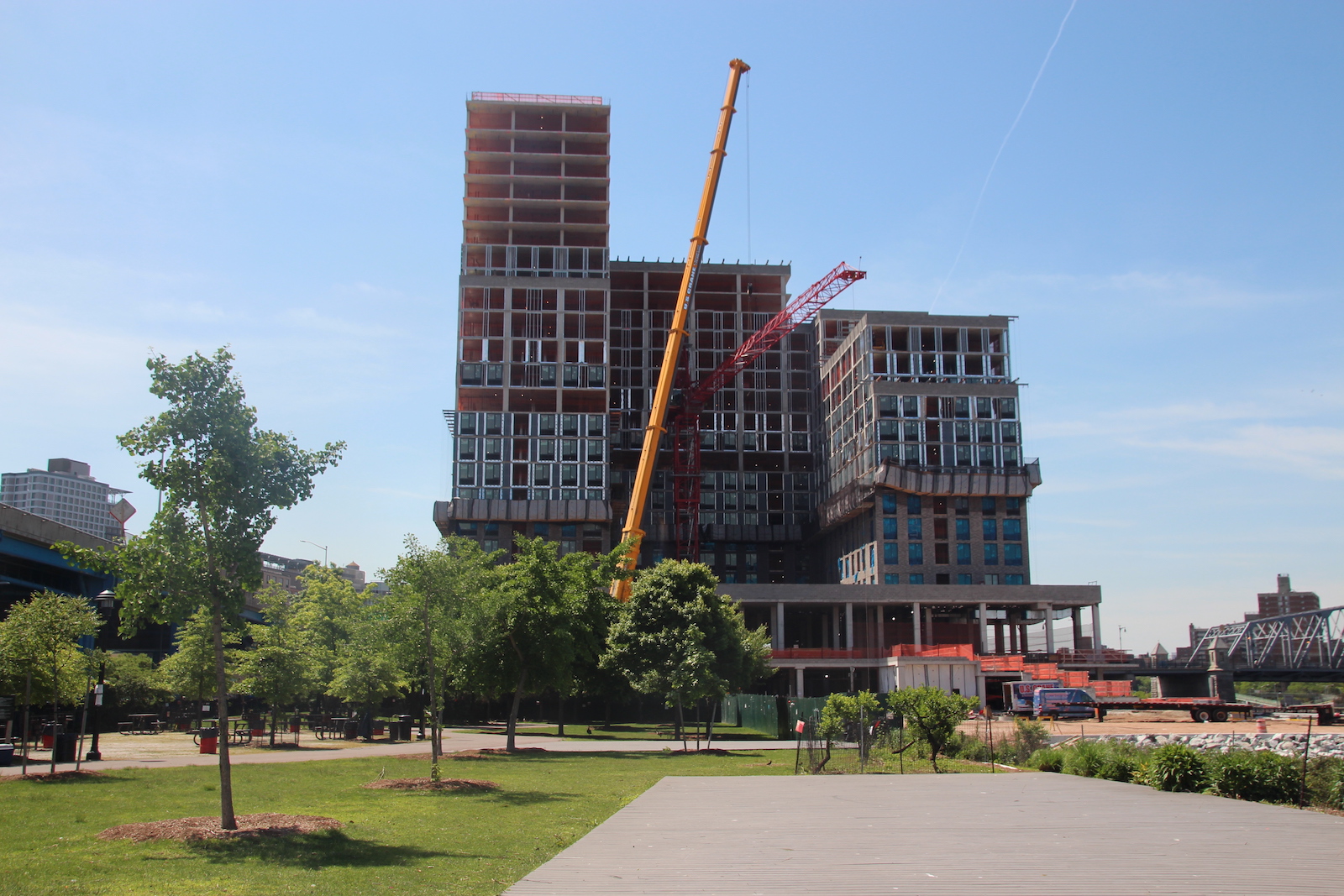
“It’s the Universal Hip Hop Museum,” Ford said. “A large portion of it’s going to be about people who spent most of their formative years living in affordable housing and critiquing affordable housing through their lyrics. But also showing opportunities for young people. You can’t become what you can’t see.”
Bucano would love to see the museum team up with the United Nations for a climate-oriented summit. It’s a topic close to his heart, as he’s already noticed seasons in the Bronx shift compared to his childhood memories.
“Here we are in 2023, and we had our first snowfall at the end of February,” said Bucano. “My sons, those are gonna be the ones that are going to have to deal with climate change.”
After my tour with Bucano, I walked down to the river by myself to get a wider view of Bronx Point. I stood on a little patch of sand and stared up at the museum’s rising outline, trying to imagine where Slick Rick’s throne would eventually reside.
Even on a calm day, the waters lapped against the mossy rocks just a few feet below street level, the most recent high tide already blanketing the outcropping halfway up. It reminded me of something Ford said earlier.
“How do we deal with future tides?” the architect had asked, rhetorically, before offering his answer. “You create a space that’s flexible, that allows you to tell the history — while also leaving room for what’s going to happen tomorrow.”
This story was originally published by Grist with the headline Hip hop has been a climate voice for 50 years. Why haven’t more people noticed? on Aug 30, 2023.